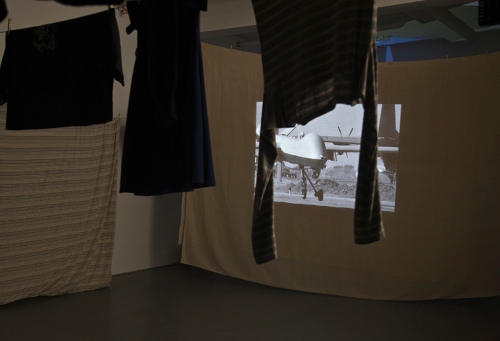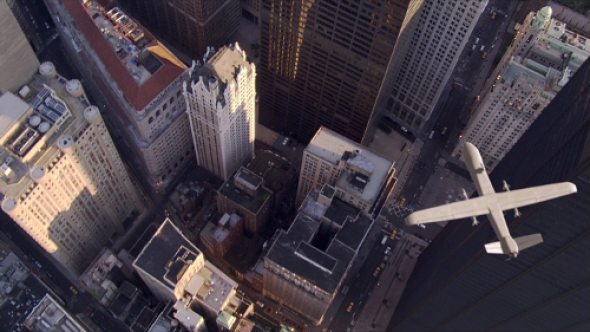View from a Kill
The morally disgusting asymmetry of drones relates not only to their deployment by the powerful against the weak, but also to the radical disparity of risk entailed in exposing the defenceless living to pilotless killing machines. In her review of George Barber’s recent film Freestone Drone, artist Kate Rich, co-creator of the first art drone 'The BIT Plane', considers the sickly prospect of a drone that assumes (a happy) consciousness
The Freestone Drone is not your regular Predator. It ignores orders, slopes off to New York and muses lyrically on its own death. The Freestone Drone (2013) is a short film by artist George Barber, conceived as a multi-screen gallery installation but viewed by this reviewer in single channel format.
On screen the Drone appears with the hump-nosed profile of General Atomics' Predator/Reaper, a weapons and surveillance unit well-known from US operations over Iraq and Afghanistan, Pakistan and Yemen. Tapping into a vein of societal unease this thousands-strong frontline killing force may have generated, Barber's film recoils from the dreadful reality on the ground, taking off on an elliptical swoosh to rove dreamily through space-time from Pearl Harbour to Asda, with a tip o the wing to Thomas the Tank Engine and Chris Marker's La Jetée.
The Freestone Drone is a familiar, impossible chimera – the soulful killing machine. It loops the loop and hacks its own video feed to stream TV programmes about outer space back to its probably incandescent handlers. A rebel spirit well beyond the sentient capacity of Battlestar Galactica's Cylon Raiders – a herd of lethal autonomous spacecraft which at one point refuse to fight and withdraw en masse from battle, possibly having developed a glimmer of free will – the Freestone Drone tracks light years on into machine consciousness. Wistful for love, it reflects on philosophy and landscape. Like Thomas the Tank Engine it can, in a commonplace manner, talk. (And argue). The film jump-cuts the evolution of empathic machines from cheeky locomotives straight to this fey Predator, implying perhaps that our collusion with the drones goes way back beyond Playstation (the usual suspect) to toddler TV.

Image: Thomas the Tank Engine. Goal: to be a really useful engine
It has to be said that artist-run drones have been around for a while. Already lost in the shadows of time, back in 1996 this reporter acting as agent of the Bureau of Inverse Technology was part of a daredevil mission to fly the BIT Plane, a miniature spy plane, deep into the heart of the Silicon Valley.
The Bureau was at the time an anonymous collective. It had settled in northern California to investigate the progress of the Information Age; in particular to explore the diffused accountability of technocratic bureaucracy this brave new era had generated. While UAVs have been pressed into military service since the 1930s, the Bureau lays claim to a shift in perspective. We took a then barely-existing prototype – the civilian unmanned flying object – into our own hands, navigating the BIT Plane own-drone, wingspan a mere 20 inches, deep into the nascent information landscape to reveal, substantially, nothing. In daring aerial manoeuvres, the Bureau's tiny spy plane buzzed a bland and lifeless landscape of corporate campuses – the no-camera zones of Lockheed, Netscape, Yahoo, Sun Microsystems, Silicon Graphics, Interval Research, Atari – the list already reads like a tour of ancient monuments. The BIT Plane's video feed returned an inscrutable stream of parking spaces, tennis courts and grainy rooftop renderings, confirming the fallacy that information is something that would or could be revealed or stolen by a camera.

Image: The flattened bureaucratic view where everything looks like nothing and there's no nuanced social sense to be made. BIT Plane (2013)
The risks however were material and specific, as while in flight the BIT Plane dove – it must be said accidentally – through the video frame, to crash land deep in the territory it was investigating.
Jumping back to 2013, the video resolution has improved by miles and – blind to the insights the BIT Plane delivered on how poorly ground-truth is judged by drones – the military deployment of UAVs accelerates apace, underwritten by the image as a priori evidence of Intelligence. A figure crosses a yard in Waziristan, drones circle invisibly overhead. The incident is ported back to an office in Nevada or New Mexico, analysed, or more likely just tagged as evidence for decisive action. A kind of 'knowledge' alien to the understanding of this reporter.
Meanwhile drone art as pioneered by the Bureau has now become an entire artistic genre. Witness for example Trevor Paglen's long range paparazzi shots of drones at home in the California desert (2006), or his public domain pics of Migrants seen by Predator Drones, US-Mexico border (2012) which admittedly trump any previous or subsequent artistic musings on space/time, having recently been launched in an actual Russian space shuttle into geostationary orbit where they are designed to stay archived for a couple of billion years.i Or Suzanne Treister whose The Drone that Filmed the Opening of its own Exhibition (2013) goes to other extremes, passing the mantle of the artist entirely to a commercially available wifi quadricopter.ii
Barber on the other hand does away with the need to get hands or even eyes on aircraft, the Freestone Drone springing forth fully formed from the edit studio, sampled, we can speculate, from military promotional materials which the artist remixes, to fly his lead character over the Manhattan skyline. Like everyone else the Freestone Drone goes to New York just to check it out, a typical tourist/artist.

Image: View of George Barber’s The Freestone Drone, Waterside Contemporary, London, 2013
Refusing the fatal equation of Image = Information, the Freestone Drone dumps its surveillance directives (suspicious gatherings of suspected people and so on), preferring to blog its favourite bits of poetic detritus back to base – plastic bags, a Starbucks cup amongst a global diaspora of franchised trash – with the forensic wonder of a passing anthropologist. An emergent auteur, modestly describing a tracking shot of tiny military figures lined up on an aircraft carrier the Freestone Drone says, ‘I feel that this sequence is one of my best, it is very ambiguous.’
The artist in his statement is careful to extract some facts from this fiction. For example, drone operators routinely study captured washing line footage to learn about their targets. It can be estimated though that any sign of Intelligence = Sheer Speculation: crack military teams like nosy parker neighbours drawing lurid conclusions from whose lingerie has been hung out next to whose overnight, but with the attendant powers to project deadly sky-borne justice.
In other news, a rising number of ‘signature’ strikes has been reported, where drones kill suspects based on behaviour patterns but without actual identification.iii ‘One man's combatant is another man's chump who went to a meeting’, former US ambassador Cameron Munter is believed to have said. Of CIA ex-director Leon Panetta, it was apparently said, ‘If Leon sees three men doing jumping jacks on the ground... that's a terrorist training camp’.iv ‘It will be a nothing type house in the middle of nowhere’, the Freestone Drone predicts, echoing perhaps the Bureau's concerns on the poverty of information as seen from the air.
Something disturbs the public about drones. We are trained from childhood not just in empathy but also fairness – the assumption of risk, however asymmetric, as a technical component of fair play. The fighter pilot assessing its own small likelihood of dying in a fireball versus the desire for a perfect score. Even video games impose a small penalty on the player – death etc. – and regardless of how easily you bounce back from that it's still a markdown. The drones, way cheaper than conventional bomber pilots and with the capability to deliver air strikes with needlepoint precision plus no repercussions (it is said), transcend most utilitarian arguments against them. In his statement the artist locates the public fear of drones not as a technical distaste – which may abate as the technology settles in – but an unformed fear of the future.
The facts on the ground are sparse. A United Nations investigation recently recorded ‘the fact that civilians have been killed or injured [...] undoubtedly raises issues of accountability and transparency.v
Like the Bureau, Barber circles back to the devastating collapse of accountability the drones embody. Who is answerable, who has been delegated the agency, who do you point to to be held accountable for specific actions? ‘I am not responsible for what I do or say’, the Freestone Drone accurately points out.
It remains to be answered what is to be done, beyond After Effects and poetry. Flying in the face of the damning evidence, the Bureau is formulating a plan to reconstruct our relationship with the drones, working off and in the fertile margins of error these massive deployments of military technology throw out.vi Meanwhile a fresh wave of superbirds is testing the airpsace. Drones For Good, bringing it all back home these UAVs are baited with humanitarian honey-traps such as fisheries observation or precision agriculture. ‘Drones for a sustainable rural life: this program proposes empowering people at rural communities with drones for monitoring and surveillance of natural resources.’ Drones for Humanity and Drone User Group Network, their tagline is: ‘Promoting the Use of Civilian Drone Technology for the Benefit of Humanity’, they also recently announced a drone social impact award. Perhaps a drone Nobel peace prize is not far off the horizon!
More happy aircraft flock to help. Real estate drones, the burritocopter, a hail of gadgets delivering sushi, beer or even individual cupcakes. The excitement is slightly premature it should be said, as the regulatory framework required for civilian, and commercial, drone flights is still on most national drawing boards.vii
And despite the disarming mission directives, the same old command and control systems remain in place, in no way willing to address, redress or even recognise the militarisation of technical culture the drones represent or the structures of participation that this generates. ‘Could I ever be a nice drone?’ the Freestone Drone ponders in its squeaky voice. Dolphin of the skies, going AWOL over lower Manhattan with just a coupla rockets it immediately calls time on this particular fantasy.
Kate Rich <kate AT irational.org> is roving reporter for the Bureau of Inverse Technology (B.I.T). The next recorded screening of the Freestone Drone is on Monday 10 February 2014 at Tate Britain, as part of: Assembly: A Survey of Recent Artists’ Film and Video in Britain 2008–2013
Footnotes
i http://creativetime.org/projects/the-last-pictures
ii http://www.annelyjudafineart.co.uk/artists/treiste...
iii http://rt.com/usa/cia-drone-strikes-unknown-target...
iv http://unmanned.warcosts.com/stream
v http://www.truth-out.org/video/item/19671-as-us-fa....
vihttp://dronecenter.bard.edu/interview-natalie-jeremijenko/
vii http://www.wired.com/threatlevel/2013/10/drones-at-a-crossroads
Mute Books Orders
For Mute Books distribution contact Anagram Books
contact@anagrambooks.com
For online purchases visit anagrambooks.com







